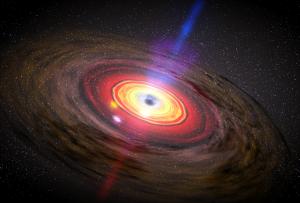Post
Hole-y War
10 September 2013
 NASA/Dana Berry, SkyWorks Digital
NASA/Dana Berry, SkyWorks DigitalYesterday I talked about black hole thermodynamics, specifically how you can write the laws of thermodynamics as laws about black holes. Central to the idea of thermodynamics is the property of entropy, which can be related to the amount of physical information a system has.
For classical black holes, this is a problem, because if you toss an object into such a black hole, the object (and all its physical information) is lost forever. It is as if the information of the object was erased, which would violate the basic principle that information cannot be destroyed. Now you might argue that being trapped is not the same thing as being destroyed, but for information it is. If you cannot recover the information, then it has been destroyed.
So it would seem that black holes “eat” information, even though the laws of thermodynamics say that shouldn’t be possible. This is known as the black hole information paradox.
Of course black holes aren’t classical. When a bit of quantum theory is introduced, you find that black holes can give off energy through Hawking radiation. It would seem then that Hawking radiation would provide a solution to the information paradox. The idea is that a black hole can trap an object and its information, but since black holes radiate via Hawking radiation (and gradually evaporate away because of it), the information is contained in the Hawking radiation and could (in principle) be recovered.
This would be a bit like ripping a book to shreds. The book falls into the shredder, but all the little book-bits fall out of the shredder. If you could gather them all up and reassemble the book, the information of the book isn’t really lost. But this leads to another problem, known as the firewall paradox.
The original idea of Hawking radiation stems from the uncertainty principle in quantum theory. In quantum theory there are limits to what can be known about an object. For example, you cannot know an object’s exact energy. Because of this uncertainty, the energy of a system can fluctuate spontaneously, so long as its average remains constant. What Hawking demonstrated is that near the event horizon of a black hole pairs of particles can appear, where one particle becomes trapped within the event horizon (reducing the black holes mass slightly) while the other can escape as radiation (carrying away a bit of the black hole’s energy).
Because these quantum particles appear in pairs, they are “entangled” (connected in a quantum way). This doesn’t matter much, unless you want Hawking radiation to radiate the information contained within the black hole. In Hawking’s original formulation, the particles appeared randomly, so the radiation emanating from the black hole was purely random. Thus Hawking radiation would not allow you to recover any trapped information.
To allow Hawking radiation to carry information out of the black hole, the entangled connection between particle pairs must be broken at the event horizon, so that the escaping particle can instead be entangled with the information-carrying matter within the black hole. This breaking of the original entanglement would make the escaping particles appear as an intense “firewall” at the surface of the event horizon. This would mean that anything falling toward the black hole wouldn’t make it into the black hole. Instead it would be vaporized by Hawking radiation when it reached the event horizon.
It would seem then that either the physical information of an object is lost when it falls into a black hole (information paradox) or objects are vaporized before entering a black hole (firewall paradox). Basically these ideas strike at the heart of the contradiction between general relativity and quantum theory.
Just how this all might be resolved isn’t yet clear. This is cutting edge theoretical physics, so we don’t have a solution yet. But because the problem is central to our understanding of quantum gravity the controversy it’s worth studying.
Of course it should be stressed that these are theoretical paradoxes. While we’re pretty sure Hawking radiation is real, it hasn’t been observed. We have no way of observing any firewall either. We do know that black holes exist, and we have a pretty good handle on the dynamics of material near a black hole. We just don’t yet understand exactly what happens when matter crosses a black hole’s event horizon.
Which is why some black hole theorists are having a hole-y war.